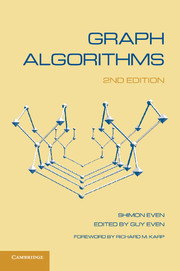8 - Testing Graph Planarity
Published online by Cambridge University Press: 05 June 2012
Summary
Introduction
There are two known planarity testing algorithms that have been shown to be realizable in a way that achieves linear time (O(|V|)). The idea in both is to follow the decisions to be made during the planar construction of the graph, piece by piece, as to the relative location of the various pieces. The construction is not carried out explicitly because there are difficulties, such as the crowding of elements into a relatively small portion of the area allocated, which, as yet, we do not know to avoid. Also, an explicit drawing of the graph is not necessary, as we shall see, to decide whether such a drawing is possible. We shall imagine that such a realization is being carried out, but will only decide where the various pieces are laid relative to each other, and not their exact shape. Such decisions may change later to make a place for later additions of pieces. In both cases, it was shown that the algorithm terminates within (O(|V|)) steps, and if it fails to find a “realization,” then none exists.
The first algorithm starts by finding a simple circuit and adding to it one simple path at a time. Each such new path connects two old vertices via new edges and vertices. (Whole pieces are sometimes flipped over, around some line). Thus, we call it the path addition algorithm. The basic ideas were suggested by various authors, such as Auslander and Parter [1] and Goldstein [2], but the algorithm in its present form, both from the graph-theoretic point of view, and complexity point of view, is the contribution of Hopcroft and Tarjan [3].
- Type
- Chapter
- Information
- Graph Algorithms , pp. 168 - 186Publisher: Cambridge University PressPrint publication year: 2011



